HLTENN003/004: CVA Patient Case Study & Nursing Care Plan at TAFE
VerifiedAdded on 2023/06/07
|29
|8147
|79
Case Study
AI Summary
This assignment presents a case study of Mr. Saheed Bott, a 69-year-old CVA patient with right-sided hemiplegia, dysphagia, and dysphasia. The solution identifies factors to consider during assessment, including age, medical history, and conscious state. It outlines physical and psychological factors for the care plan, such as addressing his age, potential social isolation due to the loss of his wife, and his existing colostomy. The response also details neurological assessments, cultural considerations for care planning, and steps for colostomy bag changes. Furthermore, it discusses risks associated with immobility and the use of the Falls Risk Assessment Tool (FRAT) before moving the patient. This document is available on Desklib, where students can find a variety of solved assignments and study resources.
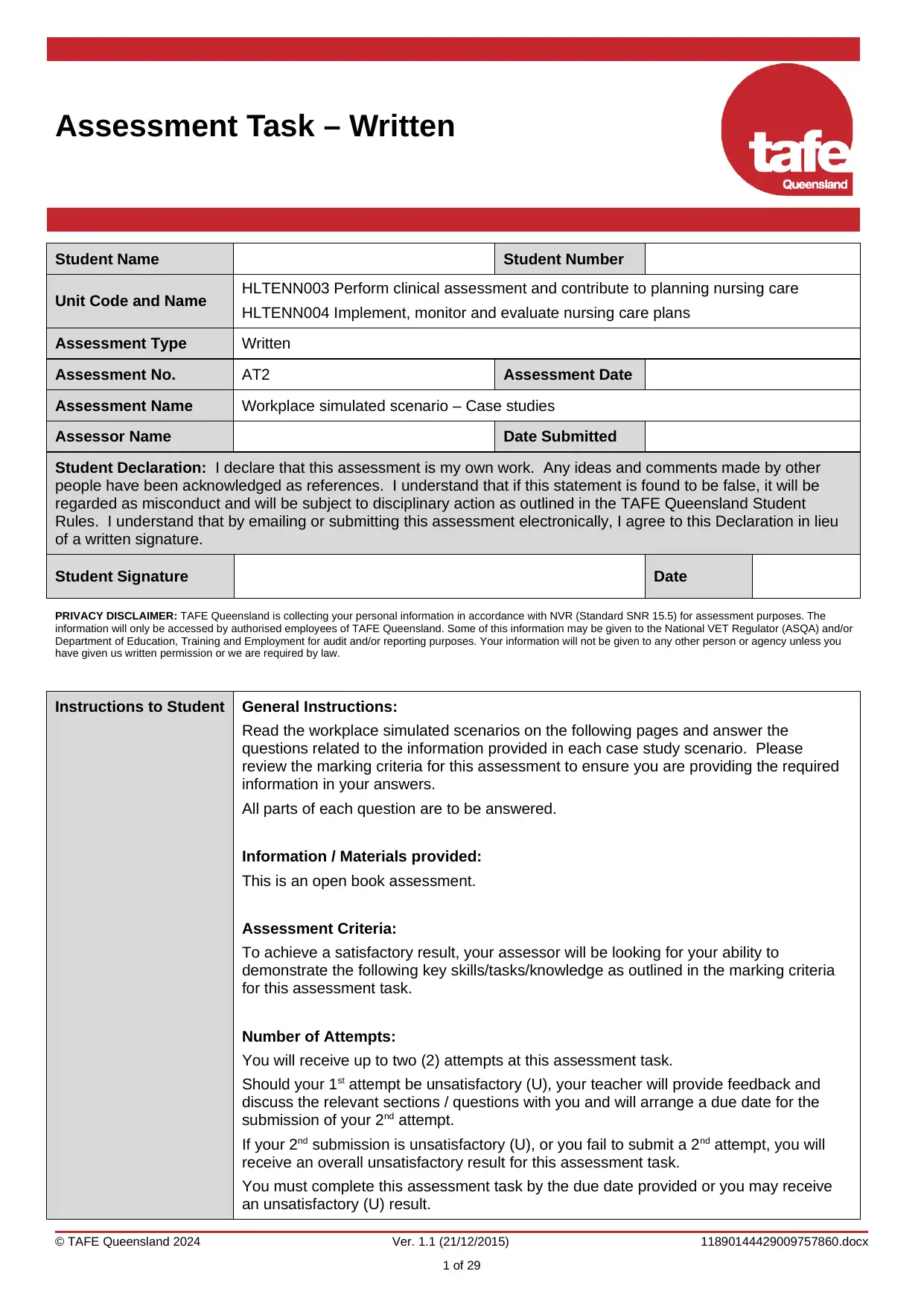
Assessment Task – Written
Student Name Student Number
Unit Code and Name HLTENN003 Perform clinical assessment and contribute to planning nursing care
HLTENN004 Implement, monitor and evaluate nursing care plans
Assessment Type Written
Assessment No. AT2 Assessment Date
Assessment Name Workplace simulated scenario – Case studies
Assessor Name Date Submitted
Student Declaration: I declare that this assessment is my own work. Any ideas and comments made by other
people have been acknowledged as references. I understand that if this statement is found to be false, it will be
regarded as misconduct and will be subject to disciplinary action as outlined in the TAFE Queensland Student
Rules. I understand that by emailing or submitting this assessment electronically, I agree to this Declaration in lieu
of a written signature.
Student Signature Date
PRIVACY DISCLAIMER: TAFE Queensland is collecting your personal information in accordance with NVR (Standard SNR 15.5) for assessment purposes. The
information will only be accessed by authorised employees of TAFE Queensland. Some of this information may be given to the National VET Regulator (ASQA) and/or
Department of Education, Training and Employment for audit and/or reporting purposes. Your information will not be given to any other person or agency unless you
have given us written permission or we are required by law.
Instructions to Student General Instructions:
Read the workplace simulated scenarios on the following pages and answer the
questions related to the information provided in each case study scenario. Please
review the marking criteria for this assessment to ensure you are providing the required
information in your answers.
All parts of each question are to be answered.
Information / Materials provided:
This is an open book assessment.
Assessment Criteria:
To achieve a satisfactory result, your assessor will be looking for your ability to
demonstrate the following key skills/tasks/knowledge as outlined in the marking criteria
for this assessment task.
Number of Attempts:
You will receive up to two (2) attempts at this assessment task.
Should your 1st attempt be unsatisfactory (U), your teacher will provide feedback and
discuss the relevant sections / questions with you and will arrange a due date for the
submission of your 2nd attempt.
If your 2nd submission is unsatisfactory (U), or you fail to submit a 2nd attempt, you will
receive an overall unsatisfactory result for this assessment task.
You must complete this assessment task by the due date provided or you may receive
an unsatisfactory (U) result.
© TAFE Queensland 2024 Ver. 1.1 (21/12/2015) 11890144429009757860.docx
1 of 29
Student Name Student Number
Unit Code and Name HLTENN003 Perform clinical assessment and contribute to planning nursing care
HLTENN004 Implement, monitor and evaluate nursing care plans
Assessment Type Written
Assessment No. AT2 Assessment Date
Assessment Name Workplace simulated scenario – Case studies
Assessor Name Date Submitted
Student Declaration: I declare that this assessment is my own work. Any ideas and comments made by other
people have been acknowledged as references. I understand that if this statement is found to be false, it will be
regarded as misconduct and will be subject to disciplinary action as outlined in the TAFE Queensland Student
Rules. I understand that by emailing or submitting this assessment electronically, I agree to this Declaration in lieu
of a written signature.
Student Signature Date
PRIVACY DISCLAIMER: TAFE Queensland is collecting your personal information in accordance with NVR (Standard SNR 15.5) for assessment purposes. The
information will only be accessed by authorised employees of TAFE Queensland. Some of this information may be given to the National VET Regulator (ASQA) and/or
Department of Education, Training and Employment for audit and/or reporting purposes. Your information will not be given to any other person or agency unless you
have given us written permission or we are required by law.
Instructions to Student General Instructions:
Read the workplace simulated scenarios on the following pages and answer the
questions related to the information provided in each case study scenario. Please
review the marking criteria for this assessment to ensure you are providing the required
information in your answers.
All parts of each question are to be answered.
Information / Materials provided:
This is an open book assessment.
Assessment Criteria:
To achieve a satisfactory result, your assessor will be looking for your ability to
demonstrate the following key skills/tasks/knowledge as outlined in the marking criteria
for this assessment task.
Number of Attempts:
You will receive up to two (2) attempts at this assessment task.
Should your 1st attempt be unsatisfactory (U), your teacher will provide feedback and
discuss the relevant sections / questions with you and will arrange a due date for the
submission of your 2nd attempt.
If your 2nd submission is unsatisfactory (U), or you fail to submit a 2nd attempt, you will
receive an overall unsatisfactory result for this assessment task.
You must complete this assessment task by the due date provided or you may receive
an unsatisfactory (U) result.
© TAFE Queensland 2024 Ver. 1.1 (21/12/2015) 11890144429009757860.docx
1 of 29
Paraphrase This Document
Need a fresh take? Get an instant paraphrase of this document with our AI Paraphraser
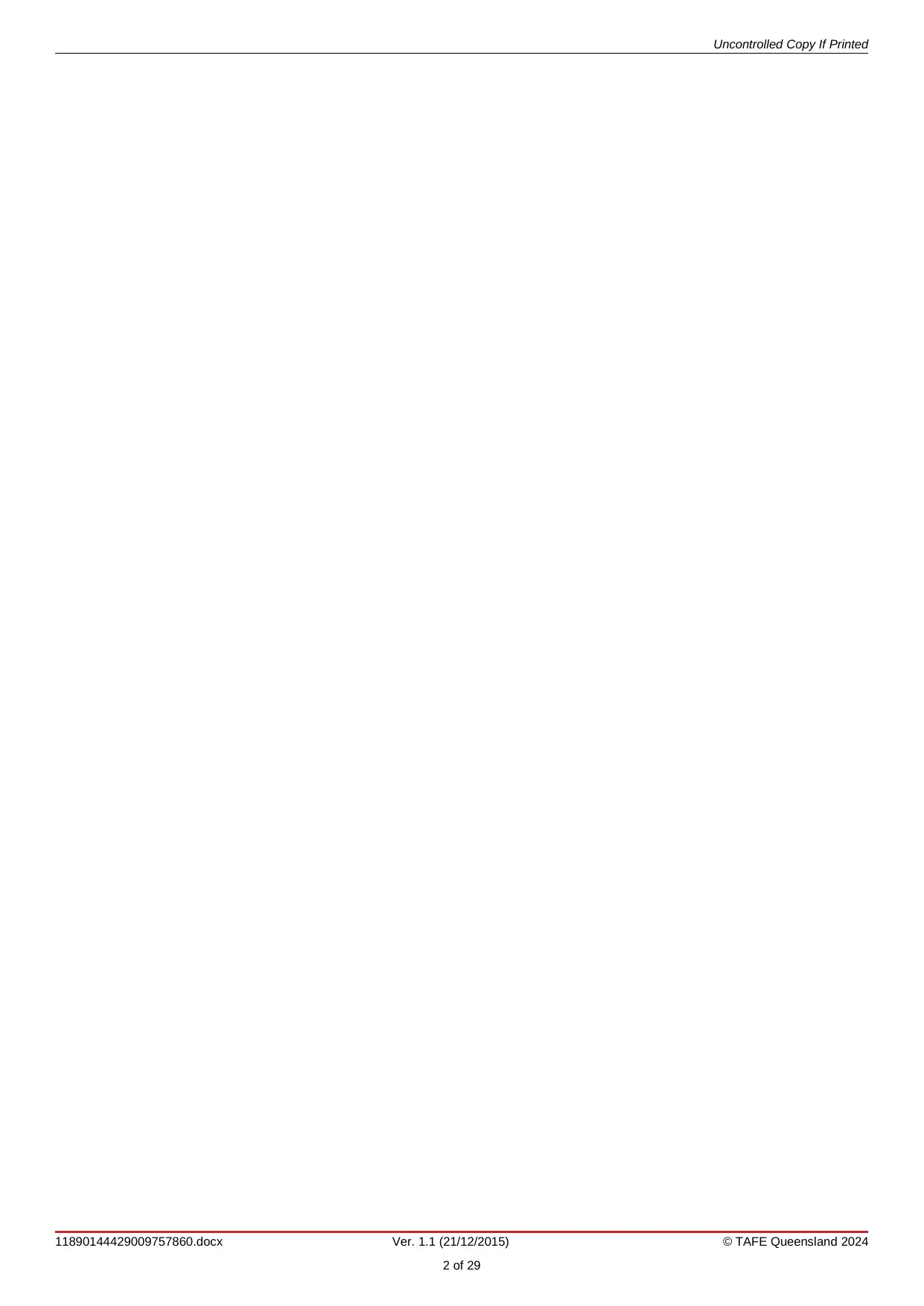
Uncontrolled Copy If Printed
11890144429009757860.docx Ver. 1.1 (21/12/2015) © TAFE Queensland 2024
2 of 29
11890144429009757860.docx Ver. 1.1 (21/12/2015) © TAFE Queensland 2024
2 of 29
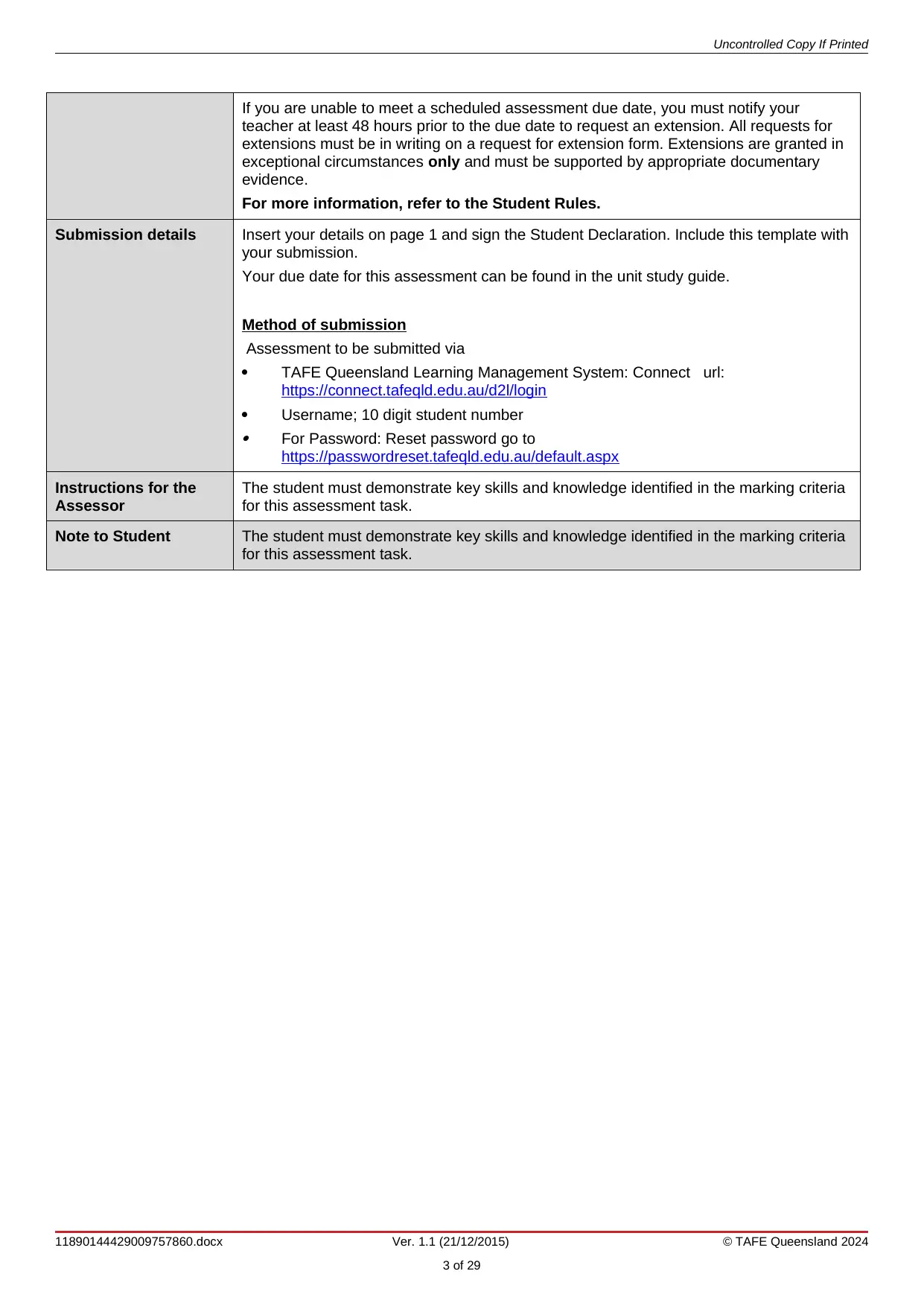
Uncontrolled Copy If Printed
If you are unable to meet a scheduled assessment due date, you must notify your
teacher at least 48 hours prior to the due date to request an extension. All requests for
extensions must be in writing on a request for extension form. Extensions are granted in
exceptional circumstances only and must be supported by appropriate documentary
evidence.
For more information, refer to the Student Rules.
Submission details Insert your details on page 1 and sign the Student Declaration. Include this template with
your submission.
Your due date for this assessment can be found in the unit study guide.
Method of submission
Assessment to be submitted via
TAFE Queensland Learning Management System: Connect url:
https://connect.tafeqld.edu.au/d2l/login
Username; 10 digit student number
For Password: Reset password go to
https://passwordreset.tafeqld.edu.au/default.aspx
Instructions for the
Assessor
The student must demonstrate key skills and knowledge identified in the marking criteria
for this assessment task.
Note to Student The student must demonstrate key skills and knowledge identified in the marking criteria
for this assessment task.
11890144429009757860.docx Ver. 1.1 (21/12/2015) © TAFE Queensland 2024
3 of 29
If you are unable to meet a scheduled assessment due date, you must notify your
teacher at least 48 hours prior to the due date to request an extension. All requests for
extensions must be in writing on a request for extension form. Extensions are granted in
exceptional circumstances only and must be supported by appropriate documentary
evidence.
For more information, refer to the Student Rules.
Submission details Insert your details on page 1 and sign the Student Declaration. Include this template with
your submission.
Your due date for this assessment can be found in the unit study guide.
Method of submission
Assessment to be submitted via
TAFE Queensland Learning Management System: Connect url:
https://connect.tafeqld.edu.au/d2l/login
Username; 10 digit student number
For Password: Reset password go to
https://passwordreset.tafeqld.edu.au/default.aspx
Instructions for the
Assessor
The student must demonstrate key skills and knowledge identified in the marking criteria
for this assessment task.
Note to Student The student must demonstrate key skills and knowledge identified in the marking criteria
for this assessment task.
11890144429009757860.docx Ver. 1.1 (21/12/2015) © TAFE Queensland 2024
3 of 29
⊘ This is a preview!⊘
Do you want full access?
Subscribe today to unlock all pages.

Trusted by 1+ million students worldwide
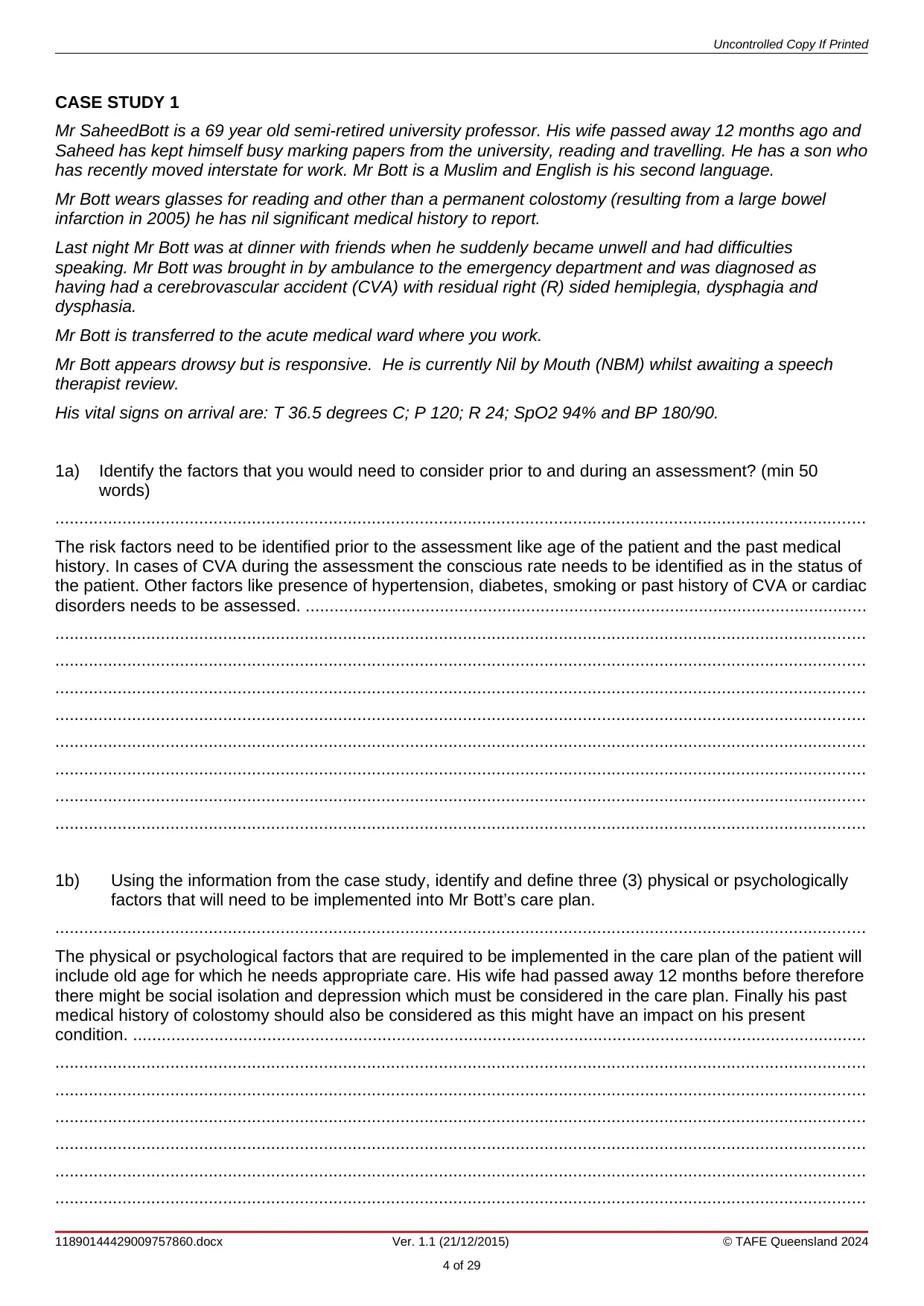
Uncontrolled Copy If Printed
CASE STUDY 1
Mr SaheedBott is a 69 year old semi-retired university professor. His wife passed away 12 months ago and
Saheed has kept himself busy marking papers from the university, reading and travelling. He has a son who
has recently moved interstate for work. Mr Bott is a Muslim and English is his second language.
Mr Bott wears glasses for reading and other than a permanent colostomy (resulting from a large bowel
infarction in 2005) he has nil significant medical history to report.
Last night Mr Bott was at dinner with friends when he suddenly became unwell and had difficulties
speaking. Mr Bott was brought in by ambulance to the emergency department and was diagnosed as
having had a cerebrovascular accident (CVA) with residual right (R) sided hemiplegia, dysphagia and
dysphasia.
Mr Bott is transferred to the acute medical ward where you work.
Mr Bott appears drowsy but is responsive. He is currently Nil by Mouth (NBM) whilst awaiting a speech
therapist review.
His vital signs on arrival are: T 36.5 degrees C; P 120; R 24; SpO2 94% and BP 180/90.
1a) Identify the factors that you would need to consider prior to and during an assessment? (min 50
words)
.........................................................................................................................................................................
The risk factors need to be identified prior to the assessment like age of the patient and the past medical
history. In cases of CVA during the assessment the conscious rate needs to be identified as in the status of
the patient. Other factors like presence of hypertension, diabetes, smoking or past history of CVA or cardiac
disorders needs to be assessed. .....................................................................................................................
.........................................................................................................................................................................
.........................................................................................................................................................................
.........................................................................................................................................................................
.........................................................................................................................................................................
.........................................................................................................................................................................
.........................................................................................................................................................................
.........................................................................................................................................................................
.........................................................................................................................................................................
1b) Using the information from the case study, identify and define three (3) physical or psychologically
factors that will need to be implemented into Mr Bott’s care plan.
.........................................................................................................................................................................
The physical or psychological factors that are required to be implemented in the care plan of the patient will
include old age for which he needs appropriate care. His wife had passed away 12 months before therefore
there might be social isolation and depression which must be considered in the care plan. Finally his past
medical history of colostomy should also be considered as this might have an impact on his present
condition. .........................................................................................................................................................
.........................................................................................................................................................................
.........................................................................................................................................................................
.........................................................................................................................................................................
.........................................................................................................................................................................
.........................................................................................................................................................................
.........................................................................................................................................................................
11890144429009757860.docx Ver. 1.1 (21/12/2015) © TAFE Queensland 2024
4 of 29
CASE STUDY 1
Mr SaheedBott is a 69 year old semi-retired university professor. His wife passed away 12 months ago and
Saheed has kept himself busy marking papers from the university, reading and travelling. He has a son who
has recently moved interstate for work. Mr Bott is a Muslim and English is his second language.
Mr Bott wears glasses for reading and other than a permanent colostomy (resulting from a large bowel
infarction in 2005) he has nil significant medical history to report.
Last night Mr Bott was at dinner with friends when he suddenly became unwell and had difficulties
speaking. Mr Bott was brought in by ambulance to the emergency department and was diagnosed as
having had a cerebrovascular accident (CVA) with residual right (R) sided hemiplegia, dysphagia and
dysphasia.
Mr Bott is transferred to the acute medical ward where you work.
Mr Bott appears drowsy but is responsive. He is currently Nil by Mouth (NBM) whilst awaiting a speech
therapist review.
His vital signs on arrival are: T 36.5 degrees C; P 120; R 24; SpO2 94% and BP 180/90.
1a) Identify the factors that you would need to consider prior to and during an assessment? (min 50
words)
.........................................................................................................................................................................
The risk factors need to be identified prior to the assessment like age of the patient and the past medical
history. In cases of CVA during the assessment the conscious rate needs to be identified as in the status of
the patient. Other factors like presence of hypertension, diabetes, smoking or past history of CVA or cardiac
disorders needs to be assessed. .....................................................................................................................
.........................................................................................................................................................................
.........................................................................................................................................................................
.........................................................................................................................................................................
.........................................................................................................................................................................
.........................................................................................................................................................................
.........................................................................................................................................................................
.........................................................................................................................................................................
.........................................................................................................................................................................
1b) Using the information from the case study, identify and define three (3) physical or psychologically
factors that will need to be implemented into Mr Bott’s care plan.
.........................................................................................................................................................................
The physical or psychological factors that are required to be implemented in the care plan of the patient will
include old age for which he needs appropriate care. His wife had passed away 12 months before therefore
there might be social isolation and depression which must be considered in the care plan. Finally his past
medical history of colostomy should also be considered as this might have an impact on his present
condition. .........................................................................................................................................................
.........................................................................................................................................................................
.........................................................................................................................................................................
.........................................................................................................................................................................
.........................................................................................................................................................................
.........................................................................................................................................................................
.........................................................................................................................................................................
11890144429009757860.docx Ver. 1.1 (21/12/2015) © TAFE Queensland 2024
4 of 29
Paraphrase This Document
Need a fresh take? Get an instant paraphrase of this document with our AI Paraphraser
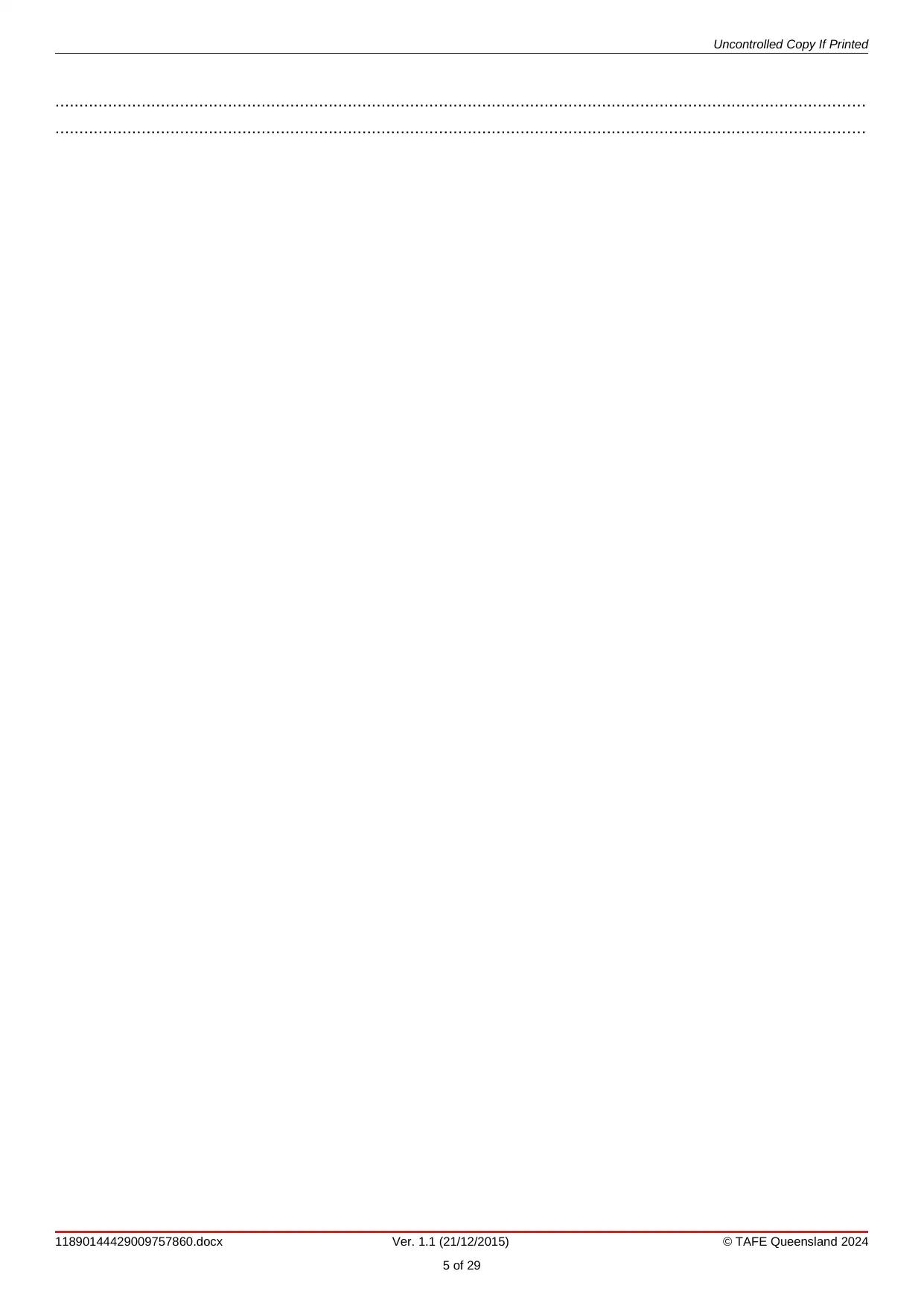
Uncontrolled Copy If Printed
.........................................................................................................................................................................
.........................................................................................................................................................................
11890144429009757860.docx Ver. 1.1 (21/12/2015) © TAFE Queensland 2024
5 of 29
.........................................................................................................................................................................
.........................................................................................................................................................................
11890144429009757860.docx Ver. 1.1 (21/12/2015) © TAFE Queensland 2024
5 of 29
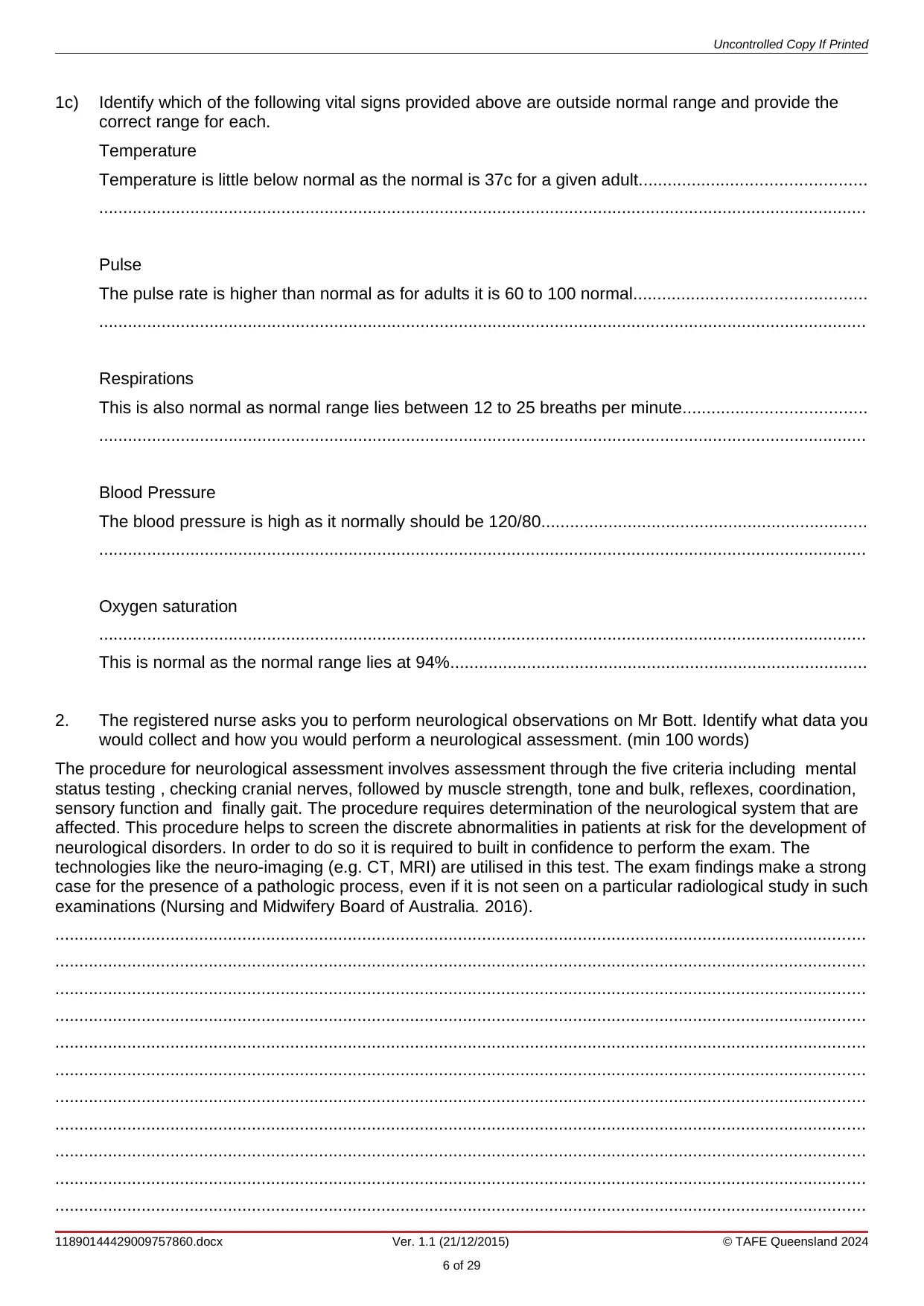
Uncontrolled Copy If Printed
1c) Identify which of the following vital signs provided above are outside normal range and provide the
correct range for each.
Temperature
Temperature is little below normal as the normal is 37c for a given adult...............................................
................................................................................................................................................................
Pulse
The pulse rate is higher than normal as for adults it is 60 to 100 normal................................................
................................................................................................................................................................
Respirations
This is also normal as normal range lies between 12 to 25 breaths per minute......................................
................................................................................................................................................................
Blood Pressure
The blood pressure is high as it normally should be 120/80....................................................................
................................................................................................................................................................
Oxygen saturation
................................................................................................................................................................
This is normal as the normal range lies at 94%.......................................................................................
2. The registered nurse asks you to perform neurological observations on Mr Bott. Identify what data you
would collect and how you would perform a neurological assessment. (min 100 words)
The procedure for neurological assessment involves assessment through the five criteria including mental
status testing , checking cranial nerves, followed by muscle strength, tone and bulk, reflexes, coordination,
sensory function and finally gait. The procedure requires determination of the neurological system that are
affected. This procedure helps to screen the discrete abnormalities in patients at risk for the development of
neurological disorders. In order to do so it is required to built in confidence to perform the exam. The
technologies like the neuro-imaging (e.g. CT, MRI) are utilised in this test. The exam findings make a strong
case for the presence of a pathologic process, even if it is not seen on a particular radiological study in such
examinations (Nursing and Midwifery Board of Australia. 2016).
.........................................................................................................................................................................
.........................................................................................................................................................................
.........................................................................................................................................................................
.........................................................................................................................................................................
.........................................................................................................................................................................
.........................................................................................................................................................................
.........................................................................................................................................................................
.........................................................................................................................................................................
.........................................................................................................................................................................
.........................................................................................................................................................................
.........................................................................................................................................................................
11890144429009757860.docx Ver. 1.1 (21/12/2015) © TAFE Queensland 2024
6 of 29
1c) Identify which of the following vital signs provided above are outside normal range and provide the
correct range for each.
Temperature
Temperature is little below normal as the normal is 37c for a given adult...............................................
................................................................................................................................................................
Pulse
The pulse rate is higher than normal as for adults it is 60 to 100 normal................................................
................................................................................................................................................................
Respirations
This is also normal as normal range lies between 12 to 25 breaths per minute......................................
................................................................................................................................................................
Blood Pressure
The blood pressure is high as it normally should be 120/80....................................................................
................................................................................................................................................................
Oxygen saturation
................................................................................................................................................................
This is normal as the normal range lies at 94%.......................................................................................
2. The registered nurse asks you to perform neurological observations on Mr Bott. Identify what data you
would collect and how you would perform a neurological assessment. (min 100 words)
The procedure for neurological assessment involves assessment through the five criteria including mental
status testing , checking cranial nerves, followed by muscle strength, tone and bulk, reflexes, coordination,
sensory function and finally gait. The procedure requires determination of the neurological system that are
affected. This procedure helps to screen the discrete abnormalities in patients at risk for the development of
neurological disorders. In order to do so it is required to built in confidence to perform the exam. The
technologies like the neuro-imaging (e.g. CT, MRI) are utilised in this test. The exam findings make a strong
case for the presence of a pathologic process, even if it is not seen on a particular radiological study in such
examinations (Nursing and Midwifery Board of Australia. 2016).
.........................................................................................................................................................................
.........................................................................................................................................................................
.........................................................................................................................................................................
.........................................................................................................................................................................
.........................................................................................................................................................................
.........................................................................................................................................................................
.........................................................................................................................................................................
.........................................................................................................................................................................
.........................................................................................................................................................................
.........................................................................................................................................................................
.........................................................................................................................................................................
11890144429009757860.docx Ver. 1.1 (21/12/2015) © TAFE Queensland 2024
6 of 29
⊘ This is a preview!⊘
Do you want full access?
Subscribe today to unlock all pages.

Trusted by 1+ million students worldwide
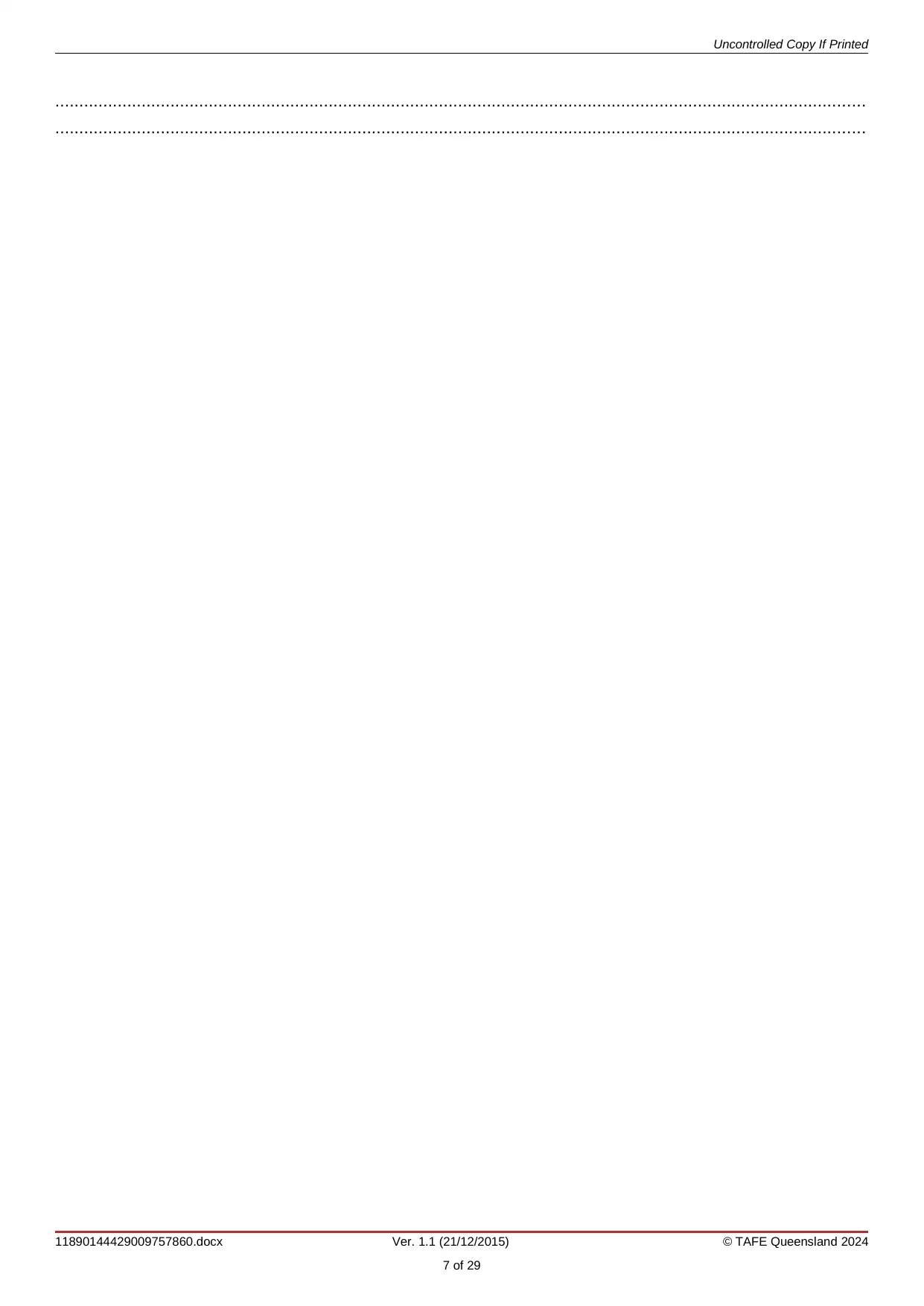
Uncontrolled Copy If Printed
.........................................................................................................................................................................
.........................................................................................................................................................................
11890144429009757860.docx Ver. 1.1 (21/12/2015) © TAFE Queensland 2024
7 of 29
.........................................................................................................................................................................
.........................................................................................................................................................................
11890144429009757860.docx Ver. 1.1 (21/12/2015) © TAFE Queensland 2024
7 of 29
Paraphrase This Document
Need a fresh take? Get an instant paraphrase of this document with our AI Paraphraser
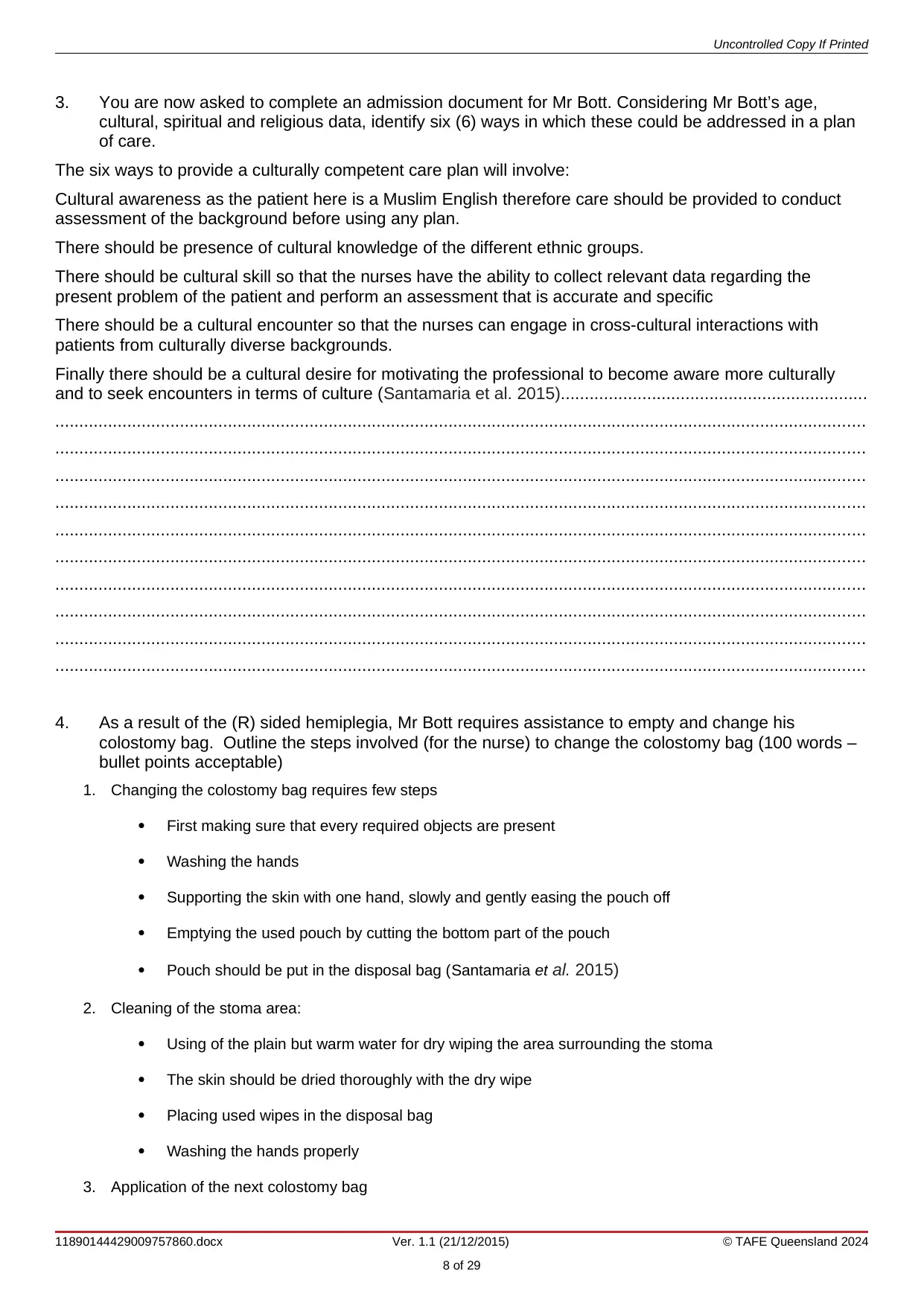
Uncontrolled Copy If Printed
3. You are now asked to complete an admission document for Mr Bott. Considering Mr Bott’s age,
cultural, spiritual and religious data, identify six (6) ways in which these could be addressed in a plan
of care.
The six ways to provide a culturally competent care plan will involve:
Cultural awareness as the patient here is a Muslim English therefore care should be provided to conduct
assessment of the background before using any plan.
There should be presence of cultural knowledge of the different ethnic groups.
There should be cultural skill so that the nurses have the ability to collect relevant data regarding the
present problem of the patient and perform an assessment that is accurate and specific
There should be a cultural encounter so that the nurses can engage in cross-cultural interactions with
patients from culturally diverse backgrounds.
Finally there should be a cultural desire for motivating the professional to become aware more culturally
and to seek encounters in terms of culture (Santamaria et al. 2015)................................................................
.........................................................................................................................................................................
.........................................................................................................................................................................
.........................................................................................................................................................................
.........................................................................................................................................................................
.........................................................................................................................................................................
.........................................................................................................................................................................
.........................................................................................................................................................................
.........................................................................................................................................................................
.........................................................................................................................................................................
.........................................................................................................................................................................
4. As a result of the (R) sided hemiplegia, Mr Bott requires assistance to empty and change his
colostomy bag. Outline the steps involved (for the nurse) to change the colostomy bag (100 words –
bullet points acceptable)
1. Changing the colostomy bag requires few steps
First making sure that every required objects are present
Washing the hands
Supporting the skin with one hand, slowly and gently easing the pouch off
Emptying the used pouch by cutting the bottom part of the pouch
Pouch should be put in the disposal bag (Santamaria et al. 2015)
2. Cleaning of the stoma area:
Using of the plain but warm water for dry wiping the area surrounding the stoma
The skin should be dried thoroughly with the dry wipe
Placing used wipes in the disposal bag
Washing the hands properly
3. Application of the next colostomy bag
11890144429009757860.docx Ver. 1.1 (21/12/2015) © TAFE Queensland 2024
8 of 29
3. You are now asked to complete an admission document for Mr Bott. Considering Mr Bott’s age,
cultural, spiritual and religious data, identify six (6) ways in which these could be addressed in a plan
of care.
The six ways to provide a culturally competent care plan will involve:
Cultural awareness as the patient here is a Muslim English therefore care should be provided to conduct
assessment of the background before using any plan.
There should be presence of cultural knowledge of the different ethnic groups.
There should be cultural skill so that the nurses have the ability to collect relevant data regarding the
present problem of the patient and perform an assessment that is accurate and specific
There should be a cultural encounter so that the nurses can engage in cross-cultural interactions with
patients from culturally diverse backgrounds.
Finally there should be a cultural desire for motivating the professional to become aware more culturally
and to seek encounters in terms of culture (Santamaria et al. 2015)................................................................
.........................................................................................................................................................................
.........................................................................................................................................................................
.........................................................................................................................................................................
.........................................................................................................................................................................
.........................................................................................................................................................................
.........................................................................................................................................................................
.........................................................................................................................................................................
.........................................................................................................................................................................
.........................................................................................................................................................................
.........................................................................................................................................................................
4. As a result of the (R) sided hemiplegia, Mr Bott requires assistance to empty and change his
colostomy bag. Outline the steps involved (for the nurse) to change the colostomy bag (100 words –
bullet points acceptable)
1. Changing the colostomy bag requires few steps
First making sure that every required objects are present
Washing the hands
Supporting the skin with one hand, slowly and gently easing the pouch off
Emptying the used pouch by cutting the bottom part of the pouch
Pouch should be put in the disposal bag (Santamaria et al. 2015)
2. Cleaning of the stoma area:
Using of the plain but warm water for dry wiping the area surrounding the stoma
The skin should be dried thoroughly with the dry wipe
Placing used wipes in the disposal bag
Washing the hands properly
3. Application of the next colostomy bag
11890144429009757860.docx Ver. 1.1 (21/12/2015) © TAFE Queensland 2024
8 of 29
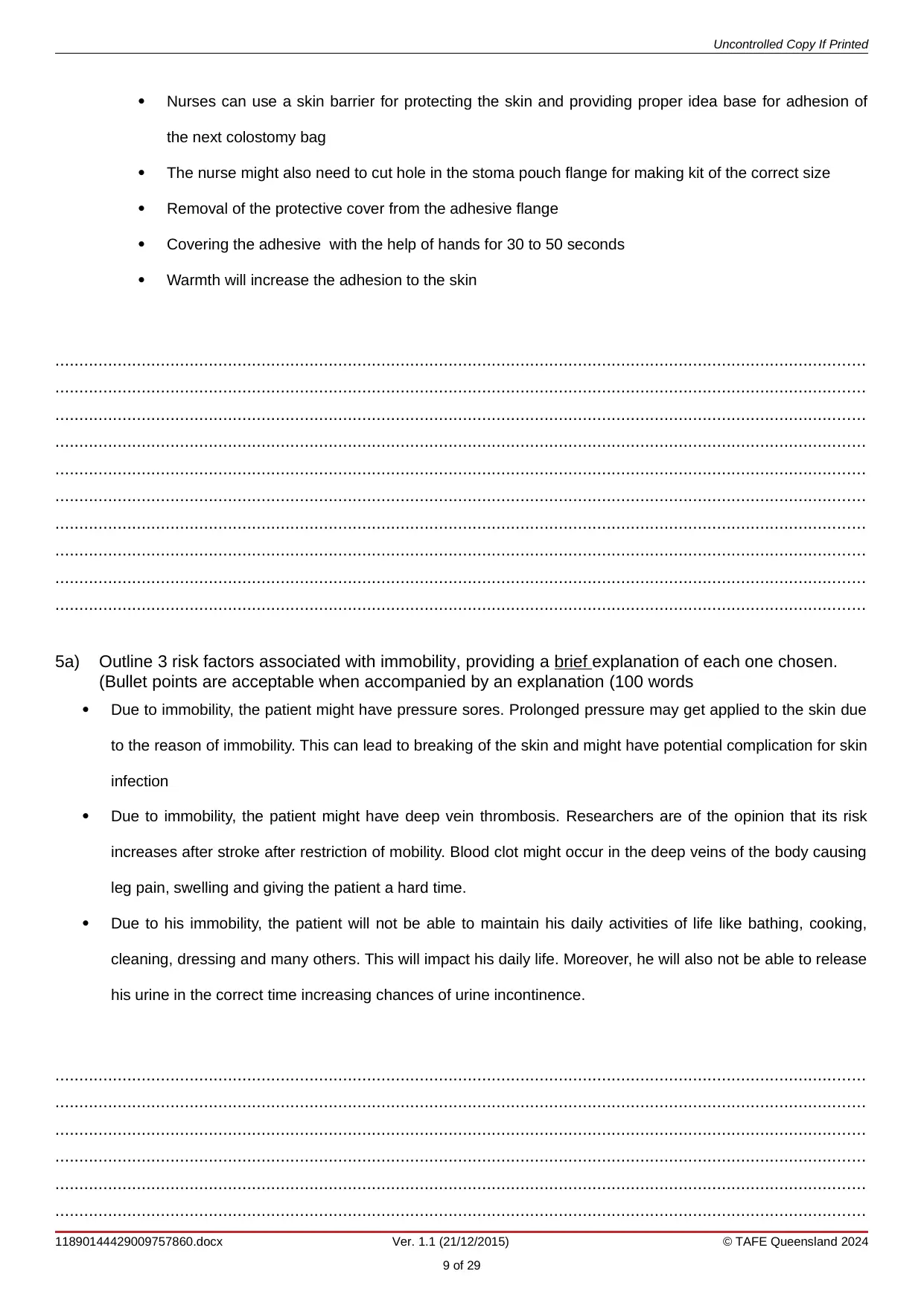
Uncontrolled Copy If Printed
Nurses can use a skin barrier for protecting the skin and providing proper idea base for adhesion of
the next colostomy bag
The nurse might also need to cut hole in the stoma pouch flange for making kit of the correct size
Removal of the protective cover from the adhesive flange
Covering the adhesive with the help of hands for 30 to 50 seconds
Warmth will increase the adhesion to the skin
.........................................................................................................................................................................
.........................................................................................................................................................................
.........................................................................................................................................................................
.........................................................................................................................................................................
.........................................................................................................................................................................
.........................................................................................................................................................................
.........................................................................................................................................................................
.........................................................................................................................................................................
.........................................................................................................................................................................
.........................................................................................................................................................................
5a) Outline 3 risk factors associated with immobility, providing a brief explanation of each one chosen.
(Bullet points are acceptable when accompanied by an explanation (100 words
Due to immobility, the patient might have pressure sores. Prolonged pressure may get applied to the skin due
to the reason of immobility. This can lead to breaking of the skin and might have potential complication for skin
infection
Due to immobility, the patient might have deep vein thrombosis. Researchers are of the opinion that its risk
increases after stroke after restriction of mobility. Blood clot might occur in the deep veins of the body causing
leg pain, swelling and giving the patient a hard time.
Due to his immobility, the patient will not be able to maintain his daily activities of life like bathing, cooking,
cleaning, dressing and many others. This will impact his daily life. Moreover, he will also not be able to release
his urine in the correct time increasing chances of urine incontinence.
.........................................................................................................................................................................
.........................................................................................................................................................................
.........................................................................................................................................................................
.........................................................................................................................................................................
.........................................................................................................................................................................
.........................................................................................................................................................................
11890144429009757860.docx Ver. 1.1 (21/12/2015) © TAFE Queensland 2024
9 of 29
Nurses can use a skin barrier for protecting the skin and providing proper idea base for adhesion of
the next colostomy bag
The nurse might also need to cut hole in the stoma pouch flange for making kit of the correct size
Removal of the protective cover from the adhesive flange
Covering the adhesive with the help of hands for 30 to 50 seconds
Warmth will increase the adhesion to the skin
.........................................................................................................................................................................
.........................................................................................................................................................................
.........................................................................................................................................................................
.........................................................................................................................................................................
.........................................................................................................................................................................
.........................................................................................................................................................................
.........................................................................................................................................................................
.........................................................................................................................................................................
.........................................................................................................................................................................
.........................................................................................................................................................................
5a) Outline 3 risk factors associated with immobility, providing a brief explanation of each one chosen.
(Bullet points are acceptable when accompanied by an explanation (100 words
Due to immobility, the patient might have pressure sores. Prolonged pressure may get applied to the skin due
to the reason of immobility. This can lead to breaking of the skin and might have potential complication for skin
infection
Due to immobility, the patient might have deep vein thrombosis. Researchers are of the opinion that its risk
increases after stroke after restriction of mobility. Blood clot might occur in the deep veins of the body causing
leg pain, swelling and giving the patient a hard time.
Due to his immobility, the patient will not be able to maintain his daily activities of life like bathing, cooking,
cleaning, dressing and many others. This will impact his daily life. Moreover, he will also not be able to release
his urine in the correct time increasing chances of urine incontinence.
.........................................................................................................................................................................
.........................................................................................................................................................................
.........................................................................................................................................................................
.........................................................................................................................................................................
.........................................................................................................................................................................
.........................................................................................................................................................................
11890144429009757860.docx Ver. 1.1 (21/12/2015) © TAFE Queensland 2024
9 of 29
⊘ This is a preview!⊘
Do you want full access?
Subscribe today to unlock all pages.

Trusted by 1+ million students worldwide
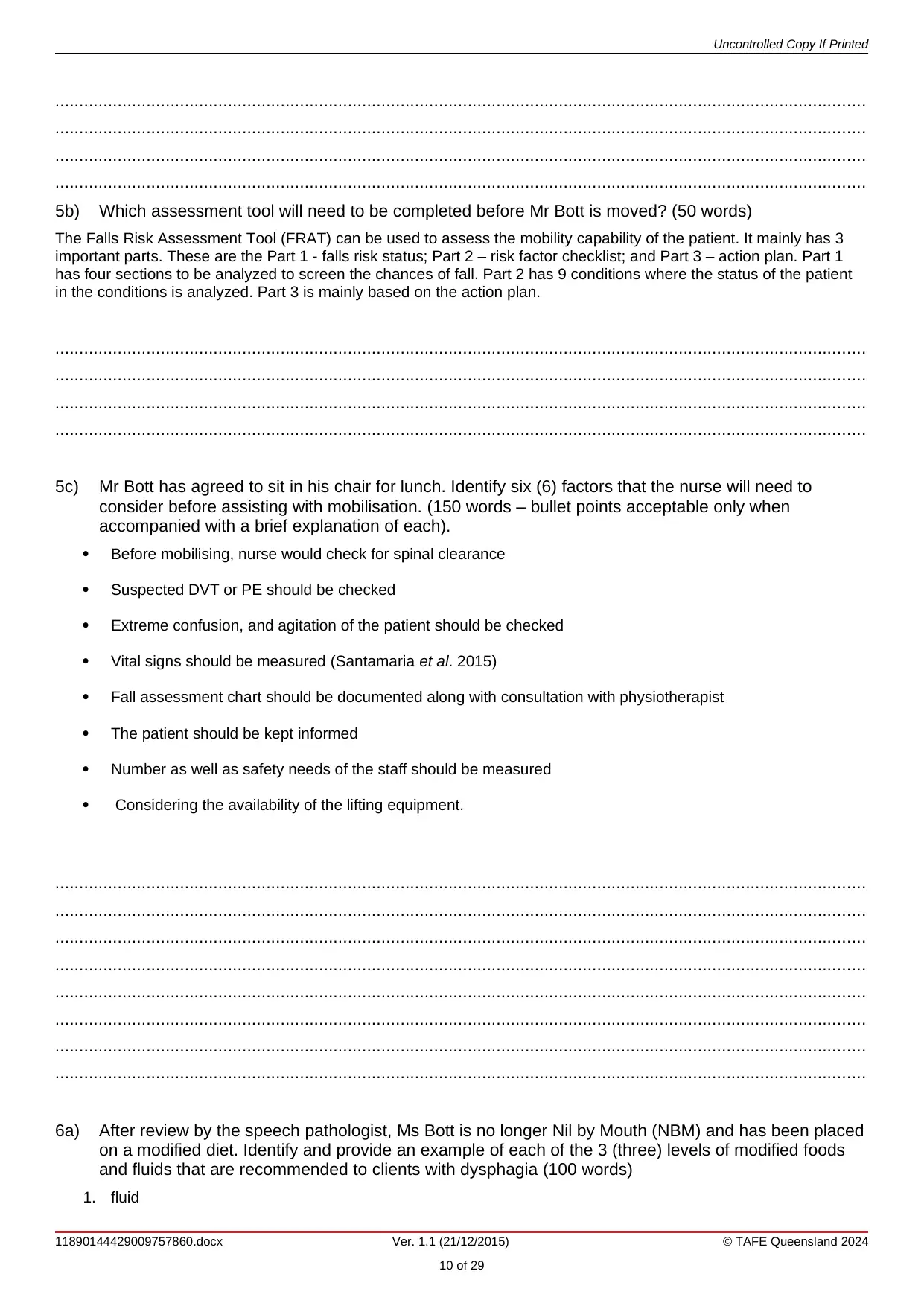
Uncontrolled Copy If Printed
.........................................................................................................................................................................
.........................................................................................................................................................................
.........................................................................................................................................................................
.........................................................................................................................................................................
5b) Which assessment tool will need to be completed before Mr Bott is moved? (50 words)
The Falls Risk Assessment Tool (FRAT) can be used to assess the mobility capability of the patient. It mainly has 3
important parts. These are the Part 1 - falls risk status; Part 2 – risk factor checklist; and Part 3 – action plan. Part 1
has four sections to be analyzed to screen the chances of fall. Part 2 has 9 conditions where the status of the patient
in the conditions is analyzed. Part 3 is mainly based on the action plan.
.........................................................................................................................................................................
.........................................................................................................................................................................
.........................................................................................................................................................................
.........................................................................................................................................................................
5c) Mr Bott has agreed to sit in his chair for lunch. Identify six (6) factors that the nurse will need to
consider before assisting with mobilisation. (150 words – bullet points acceptable only when
accompanied with a brief explanation of each).
Before mobilising, nurse would check for spinal clearance
Suspected DVT or PE should be checked
Extreme confusion, and agitation of the patient should be checked
Vital signs should be measured (Santamaria et al. 2015)
Fall assessment chart should be documented along with consultation with physiotherapist
The patient should be kept informed
Number as well as safety needs of the staff should be measured
Considering the availability of the lifting equipment.
.........................................................................................................................................................................
.........................................................................................................................................................................
.........................................................................................................................................................................
.........................................................................................................................................................................
.........................................................................................................................................................................
.........................................................................................................................................................................
.........................................................................................................................................................................
.........................................................................................................................................................................
6a) After review by the speech pathologist, Ms Bott is no longer Nil by Mouth (NBM) and has been placed
on a modified diet. Identify and provide an example of each of the 3 (three) levels of modified foods
and fluids that are recommended to clients with dysphagia (100 words)
1. fluid
11890144429009757860.docx Ver. 1.1 (21/12/2015) © TAFE Queensland 2024
10 of 29
.........................................................................................................................................................................
.........................................................................................................................................................................
.........................................................................................................................................................................
.........................................................................................................................................................................
5b) Which assessment tool will need to be completed before Mr Bott is moved? (50 words)
The Falls Risk Assessment Tool (FRAT) can be used to assess the mobility capability of the patient. It mainly has 3
important parts. These are the Part 1 - falls risk status; Part 2 – risk factor checklist; and Part 3 – action plan. Part 1
has four sections to be analyzed to screen the chances of fall. Part 2 has 9 conditions where the status of the patient
in the conditions is analyzed. Part 3 is mainly based on the action plan.
.........................................................................................................................................................................
.........................................................................................................................................................................
.........................................................................................................................................................................
.........................................................................................................................................................................
5c) Mr Bott has agreed to sit in his chair for lunch. Identify six (6) factors that the nurse will need to
consider before assisting with mobilisation. (150 words – bullet points acceptable only when
accompanied with a brief explanation of each).
Before mobilising, nurse would check for spinal clearance
Suspected DVT or PE should be checked
Extreme confusion, and agitation of the patient should be checked
Vital signs should be measured (Santamaria et al. 2015)
Fall assessment chart should be documented along with consultation with physiotherapist
The patient should be kept informed
Number as well as safety needs of the staff should be measured
Considering the availability of the lifting equipment.
.........................................................................................................................................................................
.........................................................................................................................................................................
.........................................................................................................................................................................
.........................................................................................................................................................................
.........................................................................................................................................................................
.........................................................................................................................................................................
.........................................................................................................................................................................
.........................................................................................................................................................................
6a) After review by the speech pathologist, Ms Bott is no longer Nil by Mouth (NBM) and has been placed
on a modified diet. Identify and provide an example of each of the 3 (three) levels of modified foods
and fluids that are recommended to clients with dysphagia (100 words)
1. fluid
11890144429009757860.docx Ver. 1.1 (21/12/2015) © TAFE Queensland 2024
10 of 29
Paraphrase This Document
Need a fresh take? Get an instant paraphrase of this document with our AI Paraphraser
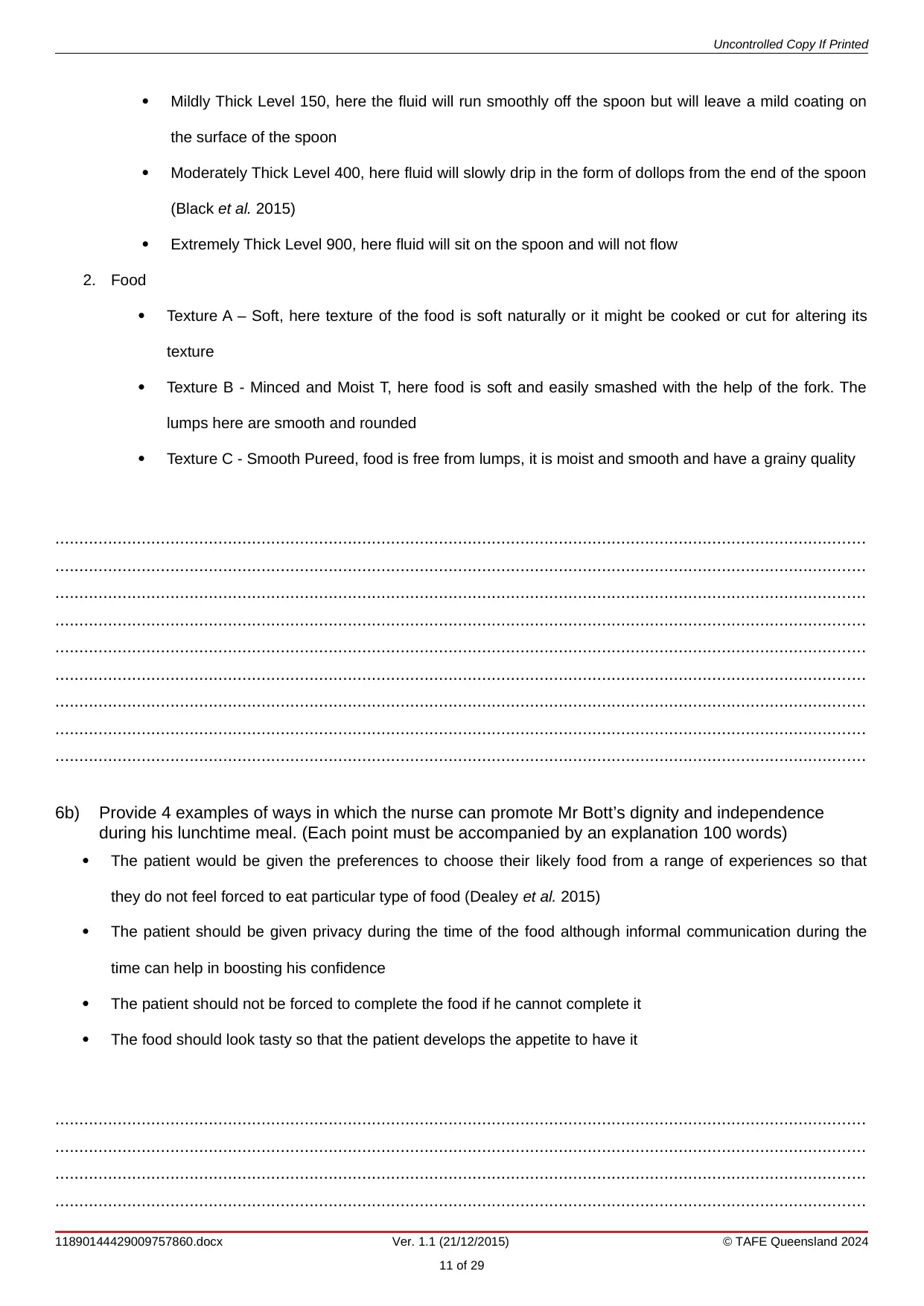
Uncontrolled Copy If Printed
Mildly Thick Level 150, here the fluid will run smoothly off the spoon but will leave a mild coating on
the surface of the spoon
Moderately Thick Level 400, here fluid will slowly drip in the form of dollops from the end of the spoon
(Black et al. 2015)
Extremely Thick Level 900, here fluid will sit on the spoon and will not flow
2. Food
Texture A – Soft, here texture of the food is soft naturally or it might be cooked or cut for altering its
texture
Texture B - Minced and Moist T, here food is soft and easily smashed with the help of the fork. The
lumps here are smooth and rounded
Texture C - Smooth Pureed, food is free from lumps, it is moist and smooth and have a grainy quality
.........................................................................................................................................................................
.........................................................................................................................................................................
.........................................................................................................................................................................
.........................................................................................................................................................................
.........................................................................................................................................................................
.........................................................................................................................................................................
.........................................................................................................................................................................
.........................................................................................................................................................................
.........................................................................................................................................................................
6b) Provide 4 examples of ways in which the nurse can promote Mr Bott’s dignity and independence
during his lunchtime meal. (Each point must be accompanied by an explanation 100 words)
The patient would be given the preferences to choose their likely food from a range of experiences so that
they do not feel forced to eat particular type of food (Dealey et al. 2015)
The patient should be given privacy during the time of the food although informal communication during the
time can help in boosting his confidence
The patient should not be forced to complete the food if he cannot complete it
The food should look tasty so that the patient develops the appetite to have it
.........................................................................................................................................................................
.........................................................................................................................................................................
.........................................................................................................................................................................
.........................................................................................................................................................................
11890144429009757860.docx Ver. 1.1 (21/12/2015) © TAFE Queensland 2024
11 of 29
Mildly Thick Level 150, here the fluid will run smoothly off the spoon but will leave a mild coating on
the surface of the spoon
Moderately Thick Level 400, here fluid will slowly drip in the form of dollops from the end of the spoon
(Black et al. 2015)
Extremely Thick Level 900, here fluid will sit on the spoon and will not flow
2. Food
Texture A – Soft, here texture of the food is soft naturally or it might be cooked or cut for altering its
texture
Texture B - Minced and Moist T, here food is soft and easily smashed with the help of the fork. The
lumps here are smooth and rounded
Texture C - Smooth Pureed, food is free from lumps, it is moist and smooth and have a grainy quality
.........................................................................................................................................................................
.........................................................................................................................................................................
.........................................................................................................................................................................
.........................................................................................................................................................................
.........................................................................................................................................................................
.........................................................................................................................................................................
.........................................................................................................................................................................
.........................................................................................................................................................................
.........................................................................................................................................................................
6b) Provide 4 examples of ways in which the nurse can promote Mr Bott’s dignity and independence
during his lunchtime meal. (Each point must be accompanied by an explanation 100 words)
The patient would be given the preferences to choose their likely food from a range of experiences so that
they do not feel forced to eat particular type of food (Dealey et al. 2015)
The patient should be given privacy during the time of the food although informal communication during the
time can help in boosting his confidence
The patient should not be forced to complete the food if he cannot complete it
The food should look tasty so that the patient develops the appetite to have it
.........................................................................................................................................................................
.........................................................................................................................................................................
.........................................................................................................................................................................
.........................................................................................................................................................................
11890144429009757860.docx Ver. 1.1 (21/12/2015) © TAFE Queensland 2024
11 of 29
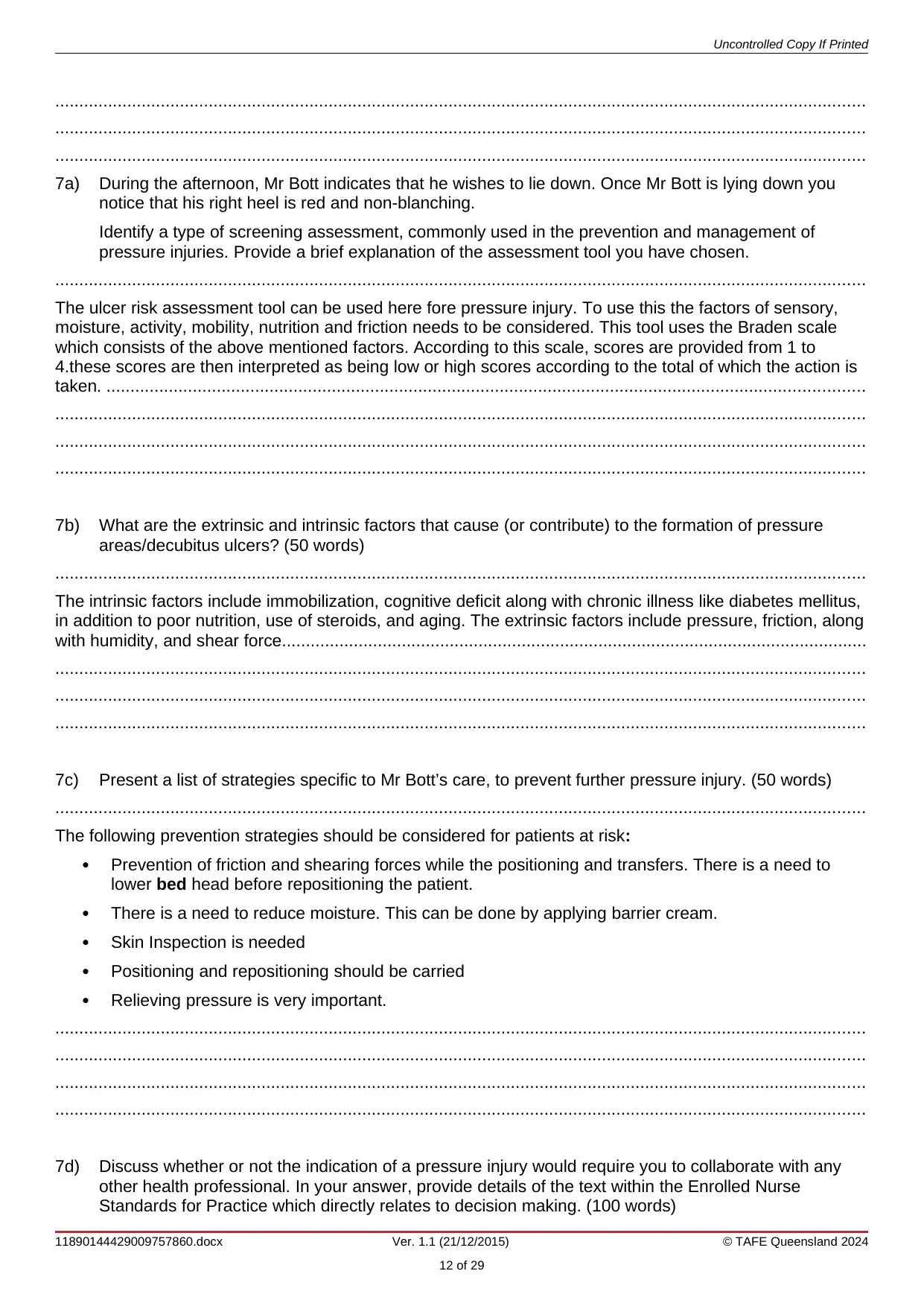
Uncontrolled Copy If Printed
.........................................................................................................................................................................
.........................................................................................................................................................................
.........................................................................................................................................................................
7a) During the afternoon, Mr Bott indicates that he wishes to lie down. Once Mr Bott is lying down you
notice that his right heel is red and non-blanching.
Identify a type of screening assessment, commonly used in the prevention and management of
pressure injuries. Provide a brief explanation of the assessment tool you have chosen.
.........................................................................................................................................................................
The ulcer risk assessment tool can be used here fore pressure injury. To use this the factors of sensory,
moisture, activity, mobility, nutrition and friction needs to be considered. This tool uses the Braden scale
which consists of the above mentioned factors. According to this scale, scores are provided from 1 to
4.these scores are then interpreted as being low or high scores according to the total of which the action is
taken. ..............................................................................................................................................................
.........................................................................................................................................................................
.........................................................................................................................................................................
.........................................................................................................................................................................
7b) What are the extrinsic and intrinsic factors that cause (or contribute) to the formation of pressure
areas/decubitus ulcers? (50 words)
.........................................................................................................................................................................
The intrinsic factors include immobilization, cognitive deficit along with chronic illness like diabetes mellitus,
in addition to poor nutrition, use of steroids, and aging. The extrinsic factors include pressure, friction, along
with humidity, and shear force..........................................................................................................................
.........................................................................................................................................................................
.........................................................................................................................................................................
.........................................................................................................................................................................
7c) Present a list of strategies specific to Mr Bott’s care, to prevent further pressure injury. (50 words)
.........................................................................................................................................................................
The following prevention strategies should be considered for patients at risk:
Prevention of friction and shearing forces while the positioning and transfers. There is a need to
lower bed head before repositioning the patient.
There is a need to reduce moisture. This can be done by applying barrier cream.
Skin Inspection is needed
Positioning and repositioning should be carried
Relieving pressure is very important.
.........................................................................................................................................................................
.........................................................................................................................................................................
.........................................................................................................................................................................
.........................................................................................................................................................................
7d) Discuss whether or not the indication of a pressure injury would require you to collaborate with any
other health professional. In your answer, provide details of the text within the Enrolled Nurse
Standards for Practice which directly relates to decision making. (100 words)
11890144429009757860.docx Ver. 1.1 (21/12/2015) © TAFE Queensland 2024
12 of 29
.........................................................................................................................................................................
.........................................................................................................................................................................
.........................................................................................................................................................................
7a) During the afternoon, Mr Bott indicates that he wishes to lie down. Once Mr Bott is lying down you
notice that his right heel is red and non-blanching.
Identify a type of screening assessment, commonly used in the prevention and management of
pressure injuries. Provide a brief explanation of the assessment tool you have chosen.
.........................................................................................................................................................................
The ulcer risk assessment tool can be used here fore pressure injury. To use this the factors of sensory,
moisture, activity, mobility, nutrition and friction needs to be considered. This tool uses the Braden scale
which consists of the above mentioned factors. According to this scale, scores are provided from 1 to
4.these scores are then interpreted as being low or high scores according to the total of which the action is
taken. ..............................................................................................................................................................
.........................................................................................................................................................................
.........................................................................................................................................................................
.........................................................................................................................................................................
7b) What are the extrinsic and intrinsic factors that cause (or contribute) to the formation of pressure
areas/decubitus ulcers? (50 words)
.........................................................................................................................................................................
The intrinsic factors include immobilization, cognitive deficit along with chronic illness like diabetes mellitus,
in addition to poor nutrition, use of steroids, and aging. The extrinsic factors include pressure, friction, along
with humidity, and shear force..........................................................................................................................
.........................................................................................................................................................................
.........................................................................................................................................................................
.........................................................................................................................................................................
7c) Present a list of strategies specific to Mr Bott’s care, to prevent further pressure injury. (50 words)
.........................................................................................................................................................................
The following prevention strategies should be considered for patients at risk:
Prevention of friction and shearing forces while the positioning and transfers. There is a need to
lower bed head before repositioning the patient.
There is a need to reduce moisture. This can be done by applying barrier cream.
Skin Inspection is needed
Positioning and repositioning should be carried
Relieving pressure is very important.
.........................................................................................................................................................................
.........................................................................................................................................................................
.........................................................................................................................................................................
.........................................................................................................................................................................
7d) Discuss whether or not the indication of a pressure injury would require you to collaborate with any
other health professional. In your answer, provide details of the text within the Enrolled Nurse
Standards for Practice which directly relates to decision making. (100 words)
11890144429009757860.docx Ver. 1.1 (21/12/2015) © TAFE Queensland 2024
12 of 29
⊘ This is a preview!⊘
Do you want full access?
Subscribe today to unlock all pages.

Trusted by 1+ million students worldwide
1 out of 29
Related Documents
Your All-in-One AI-Powered Toolkit for Academic Success.
+13062052269
info@desklib.com
Available 24*7 on WhatsApp / Email
![[object Object]](/_next/static/media/star-bottom.7253800d.svg)
Unlock your academic potential
Copyright © 2020–2025 A2Z Services. All Rights Reserved. Developed and managed by ZUCOL.

